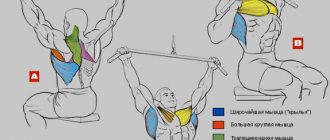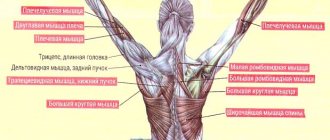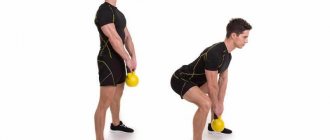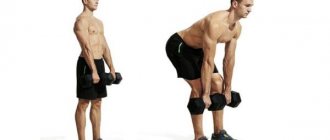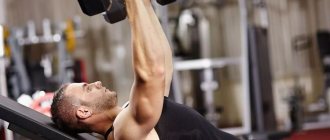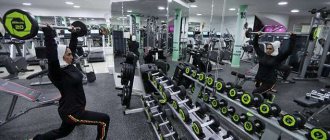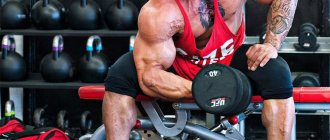Author: Timko Ilya - the ruler of the entire site and fitness trainer | more details >> Rod. 1984 Trained since 1999 Trained since 2007. Author and creator of the site tvoytrener.com. CCM in powerlifting. Champion of Russia and South Russia according to AWPC. Champion of the Krasnodar region according to IPF. 1st category in weightlifting. 2-time winner of the Krasnodar Territory championship in t/a. Author of more than 700 articles on fitness and amateur athletics. Author and co-author of 5 books.
Place in the ranking of authors:
out of competition
(become an author) Date: 2012-05-29 Views: 1,783,866 Rating: 4.9
| All articles by the author >> | Medals articles >> |
Articles are loading...
| Article medals: | article in TOP 50 | more than 1 million views |
Why medals are given to articles:
| Bronze medal: | |
| 1. The article is in the TOP 100 2. The article has more than 3. The article has more than 100 | |
| Silver medal: | |
| 1. The article is in the TOP 50 2. The article has more than 3. The article has more than 500 | |
| Gold medal: | |
| 1. The article is in the TOP 10 2. The article has more than 1 3. The article has more than 1,000 | |
Primary muscles - latissimus Additional - biceps, rear deltoid, teres major and rhomboids Difficulty - medium
Different grips for vertical block rows
- Narrow grip.
This grip allows you to use a much larger amplitude, which leads to better work of the back muscles, and therefore to their more effective development, but in this case most of the load will go directly to the biceps muscles .
- Wide grip . Vertical rows with a wide grip remove the biceps muscles from working, but the range of motion is noticeably reduced, which leads to a decrease in the effectiveness of this exercise. But, on the other hand, such a grip helps make your back wider by working the latissimus dorsi muscles.
- Medium grip . This grip is the most effective, but you will have to choose it yourself, because it is different for each person.
- Reverse grip . This grip method allows you to pump the lower part of the latissimus dorsi muscles to a greater extent.
Stages of the exercise
The basis of the exercise is that when pulling a block vertically to the chest, it is necessary to use the biceps minimally and give maximum load to the back, because in this case the biceps is an assistant when performing the exercise. The exercise can be broken down into the following steps:
Step 1. Body position
Approach the machine with an upper block and install a bar that is comfortable for you. Remember that the choice of bar (wide, narrow, bar with a parallel grip) determines the muscle activity of a particular group. Sit on a bench under a fixed bar, position and secure your legs tightly under the soft bolsters, which will allow you to confidently hold the weight and eliminate the option of “cheating” when performing deadlifts. Raise your hands, grab the bar at the bend. When performing this exercise, you can use wrist straps, which will reduce the load on the wrist. Your back and head must be kept vertical. This is the starting position for performing vertical rows.
Step 2. Technique
Keeping your back straight, as you exhale, lower the bar of the machine until it touches the upper third of your chest, while the bar should maintain a horizontal position. Try to hold the bar in this position for 1-2 seconds, which will increase the load at the point of maximum contraction of the lats. After this, you need to smoothly raise the bar to its original position. Avoid sudden movements that can lead to injury to the elbow and shoulder joints, especially when working with heavy weights.
How to properly perform lat pulldowns on a machine
- First, you need to position the body correctly. To do this, make a slight bend in the lumbar region, now bring your elbows back. After this, you can begin to pull the simulator towards you, while making sure that the movement of the cable is strictly vertical; if the movement is at an angle, it means that you have taken the wrong starting position. During the pull, the forearms should move vertically, the block should be reached to the upper chest, while moving the elbows behind the body. The head should look up, and the lower back should be in the same position as in the starting position.
- The pull of the upper block to the chest should occur strictly from the top point of the simulator; to do this, you must hold the handle of the block on slightly bent arms, to do this, pull your shoulders up. When you begin to pull the block towards you, exhale slowly. The pull begins by lowering your shoulders, as soon as your shoulder blades come together, begin to pull the block towards your chest. As soon as the block reaches your chest, hold this position for a few seconds, then slowly return to the starting position while inhaling.
- The main thing is, throughout the entire execution of the upper pulley to the chest, do not relax the muscles!
- And also, this type of deadlift can be performed using a reverse grip, this will contribute to greater development of the biceps.
The right choice in terms of muscle activity
Several studies have been devoted to the subject of our discussion. In 2002, the Journal of Strength and Functional Training published a study in which the effects of different arm positions on muscle activity were studied using electromyography (EMG) during lat pulldowns. The following techniques were used: close grip, supinated (lower) grip, wide grip row to the chest, wide grip row behind the head.
Scientists have concluded that the wide-grip chest row provides greater activation of the latissimus dorsi muscle than any other exercise variation. This finding confirmed that lat pulldowns maximize lat development.
Pull-down of the upper block behind the head
Another study, published in the Journal of Strength and Functional Training in 2009, used EMG to examine the participation of major muscle groups (chest major, lats, posterior deltoids, biceps) in three variations of lat pull-downs. The options were: rows to the chest, behind the head and using a V-bar (narrow grip).
The activity of the latissimus muscles in all three variants was almost the same, but the participation of the pectoralis major muscle was maximum during pull-downs to the abdomen. Accordingly, the rear deltoids and biceps brachii showed maximum activity during the overhead pull-down. Considering the main goals of the exercise, the authors concluded that the lat pulldown is the optimal choice.
One-arm vertical pull-down
This type of deadlift is extremely important for everyone to do because with a two-arm deadlift, you will undoubtedly have more loads on one arm than the other. This happens due to the fact that one of a person’s arms is always stronger than the other, for example, due to various congenital pathologies such as curvature of the spine or shortened limbs. This can also happen because you trained one arm more than the other. Ultimately, one-arm rows will help you develop your arm muscles in a more balanced manner. You can also perform vertical rows with a reverse grip. The proposed type of deadlift is not recommended for girls.
The technique for performing this type of exercise remains the same as before, only here you will have to perform everything more isolated and clearly, since only one hand will pull the entire weight.
Load on the shoulder joints and rotator cuff
Muscle activity is not the only criterion for assessing lat pull; The load on the shoulder joints and rotator cuff is also a major factor. According to a study published in the Journal of Strength and Functional Training, when the shoulder joints are placed in a position of horizontal abduction in combination with external rotation (as we see with a lat pulldown), stress on the rotator cuff increases. To stabilize the humeral head, the rotator cuff muscles have to work harder, leaving them vulnerable and increasing the risk of injury, particularly tendinitis and pain.

Upper pulley to chest
Another study published in the Journal of Shoulder and Elbow Surgery showed that keeping the elbows approximately 30° anterior to the plane of the shoulder girdle reduced stress on the anterior capsule of the shoulder joint. This is only possible while pulling the upper block to the chest.
Pulling a pulley behind your head can lead to pain for other reasons. One report reported that the combination of external rotation, horizontal shoulder abduction, and severe cervical flexion during overhead pulldowns may result in temporary paralysis of the upper extremities due to injury to the brachial plexus.
Worse, if you perform the head pull too zealously in the lower phase of the movement, you can hit the cervical vertebrae with the bar, which can lead to bruising and even fracture. Good is not enough.
Thrust of the upper block in front of you
The technique for performing this type of deadlift remains the same. The peculiarity of this exercise is that the pectoral muscles are worked out to a greater extent.
Contraindications
- In principle, this exercise has almost no contraindications. The only thing is that it is strictly forbidden to perform vertical block rows if you have injuries to the shoulder girdle, hand or elbow, or if you have a hernia in the thoracic spine. So, if you have any of the above, then first consult a doctor. After a complete check, the specialist will be able to give you all the recommendations on this matter.
- When performing head pulls, many cannot perform the technique correctly. This may happen due to the fact that you have problems in the shoulder girdle. So it is not recommended for you to perform this type of deadlift.
Execution technique
- Correctly adjust the knee pad on the machine so that you can perform the exercise comfortably.
- While standing, grab the bar with your arms slightly wider than your shoulders and your palms facing forward. Keep your arms extended and sit down at the machine with your knees under the pads.
- Straighten your body so that the cable and lowering bar are directly above your spine, and tilt your head forward so that the bar can be lowered safely. Push your shoulder blades back to set your shoulders, this will allow tension to remain on your lats throughout the exercise.
- As you exhale, slowly lower the barbell behind your head until it is approximately at ear level. DO NOT lower the bar to shoulder level. While the bar is at its lowest point, squeeze your shoulder blades fully and pause for one second.
- Inhale as you slowly lift the barbell to the starting position, but stop before you fully extend your arms to maintain tension in the muscles. Without pausing, lower the bar again and repeat the process.
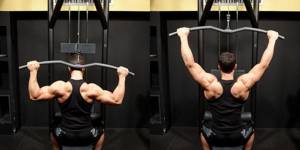
Implementation recommendations
When performing head pulls, you should avoid:
- Roll your shoulders forward. If such posture is associated with overload of the chest muscles, you need to first stretch them slightly and gently roll them with a foam roller;
- Start by bending your elbows and flexing your biceps. This allows you to redistribute the load on your arms rather than on your back;
- An asymmetrical grip, which does not allow you to load both halves of your back equally;
- Incorrect position of the legs, causing the buttocks to lift off the bench with each movement;
- Lack of leg fixation;
- Movement in jerks, due to the push of the body forward, and the force of inertia
Useful tips for beginners
- If you want to make your back wider, then you need to use a wider grip, since the grip will directly affect the formation and development of the latissimus dorsi muscles.
- Before you start pulling the block towards you, check that the starting position is correct. Your arms and back should be completely straight, and your shoulders should be pulled up. It is recommended to perform the exercise from this position.
- If you want to primarily develop the upper part of the latissimus dorsi muscles, then you need to keep your body straight and pull the vertical block straight down. If you lean back, the load will transfer to the deltoids and lower parts of the latissimus muscles.
- When performing vertical rows, using a wide grip, stop breathing, this will help you keep your body straight, and therefore will lead to greater stress on your back, and will also make the exercise as safe as possible.
- When performing a pulldown, do not use your biceps, as they should only act as a stabilizer for the elbow joint.
- Combine types of grips. There is no need to use only one execution option all the time. Since each of the grips works different muscle groups.
And the winner is...
Given the overwhelming evidence, the lat pulldown is a clear winner. By performing chest rows, you not only get similar or better muscle activity, but you also reduce the risk of shoulder, neck, or nerve damage.
Moreover, the practical benefit of pulling the upper block behind the head is very small; this movement is unlikely to be useful for any sports competitions or solving everyday problems. Therefore, the critics are right: there is no good reason to pull the top block by the head, but there are many arguments in favor of not doing it!
